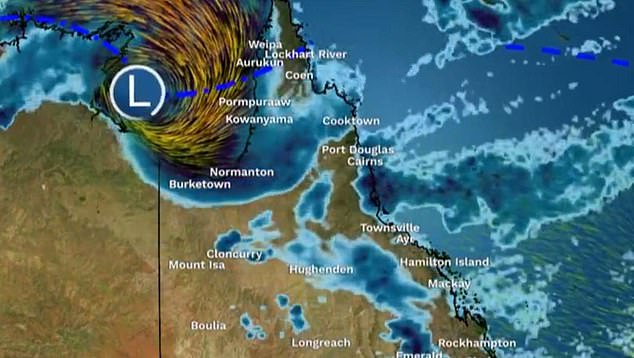Tropical cyclone expected to make landfall in Australia tonight: What you need to know
Tropical Cyclone Lincoln has formed in the Gulf of Carpentaria after a woman was found dead in floodwaters in north-west Queensland.
A third cyclone in as many months has formed off the Australian coast as rain-lashed areas prepare for even wilder weather.
Wind gusts of up to 110 km/h and heavy rainfall will hit coastal areas of the Gulf of Carpentaria after Tropical Cyclone Lincoln formed on Friday.
Tropical Cyclone Lincoln has formed in the Gulf of Carpentaria and is expected to make landfall on Friday evening.

Tropical Cyclone Lincoln has formed in the Gulf of Carpentaria after a woman was found dead in floodwaters in north-west Queensland
It will make landfall as a Category 1 system between the Northern Territory-Queensland border and Port McArthur in the NT on Friday evening.
“As it moves inland this evening, the system is expected to weaken and begin moving westwards over the central Northern Territory this weekend,” the Bureau of Meteorology said.
Some regions within sight of Lincoln are still reeling from the latest cyclone.
A woman, believed to be an Indian national, has been found dead in a car submerged in floodwaters in north-west Queensland left in the aftermath of ex-Cyclone Kirrily.
The vehicle was spotted in the flooded Malbon River at Duchess, near Mount Isa, on Thursday afternoon.
It is believed the 28-year-old woman had attempted to drive through a flooded causeway.
“Heartbreaking tragedy in Australia: An Indian national lost her life in a flooding incident near Mount Isa, Queensland,” the Indian High Commission in Australia posted on social media on Friday.
“My deepest condolences to the family of the deceased.”
Some northwestern areas remain isolated due to widespread flooding caused by former Cyclone Kirrily, which lingered for days after crossing the Queensland coast weeks ago.
Tropical Cyclone Jasper also caused record flooding in far north Queensland after making landfall north of Cairns in mid-December.
Some communities took no chances when the third cyclone of the season loomed.
In the NT people were moved from the Beswick community south of Katherine.
Burketown flooded in March 2023 and is facing another deluge, with 135mm of rain falling in 24 hours. (HANDOUT/QLD POLICE)
More than 60 residents were also evacuated from Burketown in north-west Queensland, where 135mm of rain fell in the past 24 hours.
Burke Shire Mayor Ernie Camp said while Gulf communities were used to some isolation during the wet season, successive severe weather events took their toll.
“Everyone is a bit nervous,” he told AAP.
“It certainly drains our resources, including mentally, given that these events are so close together.”
Mr Camp said supplies had been dropped into the Aboriginal community of Doomadgee, which has been cut off by flooding for more than a month.
A cyclone warning area was declared on Friday, stretching from Bing Bong in the NT to Mornington Island in Queensland.
As Lincoln approached, the agency warned people in Borroloola, NT and surrounding areas to stay indoors and remain calm with expected “dangerous” winds.
“Do not go outside if you find yourself in the eye of the cyclone,” it said.
The agency also urged people living between the Queensland-NT border and Burketown to take precautions and monitor warnings.
In addition to heavy rain and storms, the cyclone will also cause higher than normal tides in the southern Gulf region, causing minor flooding in low-lying areas.
The system is expected to weaken as it moves inland through central NT and then into northern Western Australia this weekend, bringing heavy rain.
But the agency warned the system was at a “moderate” risk of becoming a cyclone again if it reached waters west of Washington’s Kimberley later next week.
Meanwhile, heavy rain lashed southeast Queensland on Friday, causing flash flooding and road closures.
On what was described as Brisbane’s wettest day since the 2022 floods, Rosalie recorded 197mm, Bowen Hills 135mm while 148mm soaked Mt Cootha.
